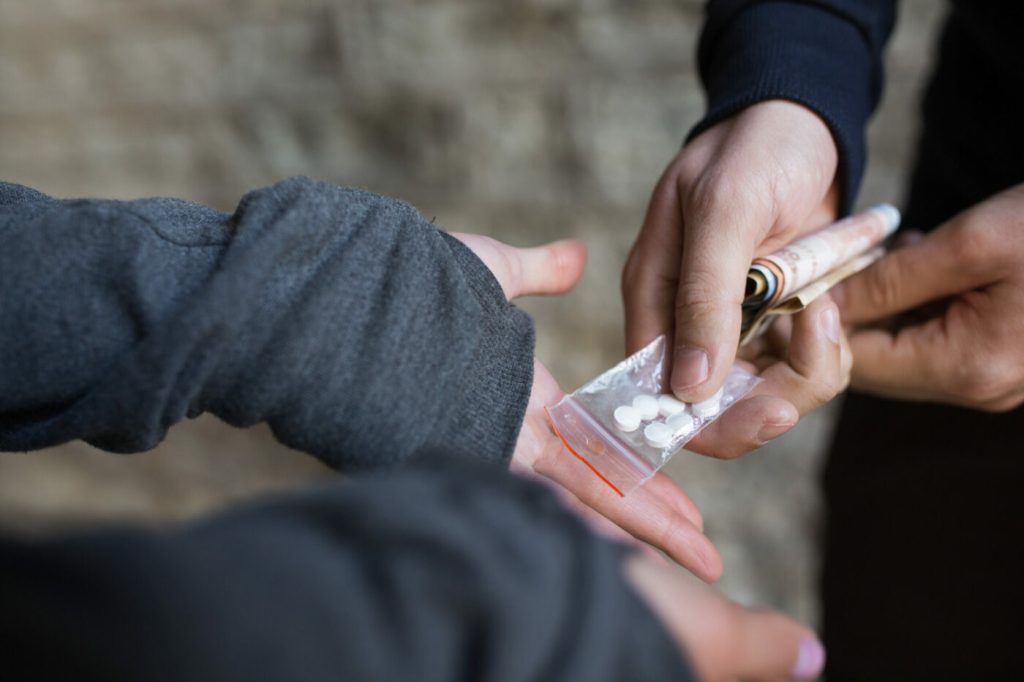The abortion pill is marketed as a simple process. Planned Parenthood describes the abortion pill as, “Really safe and effective. It’s a super common way to have an abortion, and millions of people have used it safely.”
That may be the way the abortion pill is marketed, but since Roe v. Wade was overturned, a dangerous practice has morphed into a crisis—the illegal, unmonitored exchange of pills used to end a pregnancy.
The abortion pill still poses a risk to a woman (along with the loss of a beautiful baby), even when performed using an FDA-approved prescription and monitored by a licensed medical professional with immediate access to a sterile medical facility.
By removing common safeguards, such as approved, prescribed, licensed, monitored, or sterile, medical practices, the dangers and risks of the abortion pill to a woman are compounded exponentially.
Where Is the Abortion Pill Legal?
Abortion pills are legal in some states and circumstances. Some states allow them upon request, others only in circumstances of rape, incest, fetal abnormality, or maternal risk.
Prerequisites vary, but a state that allows the use of abortion pills requires either a virtual or in-person consultation or exam and a written prescription from a licensed medical professional. The medical provider will monitor the mother and be available for questions, concerns, or emergency medical care.
What Is a Chemical Abortion?
Abortion pills make abortion possible through oral administration, which is less of a hassle for mothers than going to a clinic and receiving a surgical abortion. Abortion pills are becoming so favored that they now account for more than half of abortions in the United States. The act of terminating a pregnancy with abortion pills has many names. The most common is chemical abortion, but other more benign, dehumanizing phrases are used by abortionists, such as self-managed, at-home, medicated, and RU-486.
The abortion pill is a two-step medication process and must be taken within the first 10 weeks of pregnancy. The first medication is mifepristone, which is a drug that blocks a key pregnancy hormone: progesterone. Without progesterone, the lining of the uterus breaks down and the baby dies — a process that can be reversed if the mother acts quickly by taking progesterone.
A day or two later, the woman takes the first of four doses of misoprostol to initiate a long, grueling series of contractions that end in a stillborn baby and a bleeding mother. After this process, the woman must dispose of the expelled remains.


What Are the Dangers of a Chemical Abortion?
Each year, thousands of women suffer physical and emotional trauma from chemical abortions. Abortionists disclose the possibility of mild side effects, including abdominal or stomach pain, uterine cramping, back pain, diarrhea, dizziness, headache, nausea, or vomiting.
This is a negligent lie at the risk of every mother’s life and well-being. From 2000 to 2018, 24 women died and 4,000 women reported harmful reactions to the pill, such as hemorrhaging, excruciating abdominal pain, and life-threatening infections. According to the FDA, after chemical abortion, the average mother can expect to bleed for 9 to 16 days, and 8% of women bleed for more than 30 days.


Physical trauma
The list of side effects and potential complications of a chemical abortion is endless. While some complications may be short-lived, others will last a lifetime or cut the mother’s life short.
Here are a few of the more common complications that could happen during a chemical abortion:
The baby is born alive
There have been reports of babies being born alive following a failed chemical abortion.
Incomplete abortion
Sometimes, the abortion doesn’t work, and parts of the baby are left inside the mother. When this happens, a surgical D&C is needed to clean up the carnage.
Infection, sepsis, and death
A mother may suffer from infection, even to the point of sepsis and death. This is more common in an incomplete abortion but can happen in any chemical abortion.
Hemorrhaging, transfusions, and death
Transfusions and maternal death can happen in full-term pregnancies with healthy babies. A chemical abortion is a self-induced miscarriage, so bleeding is expected.
Sometimes, the bleeding doesn’t stop. Even with the best medical care, the mother’s body may be too traumatized to survive.
Drug side effects
The tables below shows a list of side effects for both Mifepristone and Misoprostol, according to the Mayo Clinic. It’s also important to note that the Mayo Clinic includes a long list of drug interactions and health conditions that rule out the option of a chemical abortion for the safety of the mother’s health and her very life.
Drug side effects tables
| Mifepristone |
|---|
| Abdominal or stomach pain or uterine |
| Cramping |
| Acid or sour stomach |
| Anxiety |
| Back pain |
| Belching |
| Chest pain or discomfort |
| Confusion |
| Cough or hoarseness |
| Diarrhea |
| Dizziness |
| Fainting or lightheadedness when getting up fast, weak pulse |
| Fever |
| Flu-like symptoms |
| Headache |
| Heartburn |
| Increased clear or white vaginal discharge |
| Indigestion |
| Itching of the vagina or genital area |
| Lack or loss of strength |
| Nausea or vomiting |
| Pain during sexual intercourse |
| Pain or tenderness around the eyes and cheekbones |
| Pain in the side |
| Pain in lower back |
| Pain or discomfort in the arms, jaw, back, or neck |
| Painful or difficult urination |
| Pale, cold, or clammy skin |
| Shaking chills |
| Shortness of breath |
| Stomach discomfort, upset, or pain |
| Stuffy or runny nose |
| Sudden increase in stomach or shoulder pain |
| Sweating |
| Tightness of the chest |
| Trouble sleeping |
| Troubled breathing |
| Unusual bleeding or bruising |
| Unusual or large amount of vaginal bleeding |
| Unusual tiredness or weakness |
| Misoprostol |
|---|
| Abdominal or stomach pain |
| Acid or sour stomach |
| Belching |
| Bladder pain |
| Bloated |
| Bloody nose |
| Bloody or black tarry stools |
| Bloody or cloudy urine |
| Blurred vision |
| Blistering, crusting, irritation, itching, or reddening of the skin |
| Body aches or pain |
| Breast pain |
| Burning, dry, or itching eyes |
| Change in taste |
| Chest pain |
| Chills |
| Confusion |
| Constipation |
| Cough |
| Continuing ringing or buzzing or other unexplained noise in the ears |
| Cracked, dry, scaly skin |
| Cramps |
| Diarrhea |
| Difficult, burning, or painful urination |
| Difficulty with breathing |
| Difficulty with moving |
| Difficulty with swallowing |
| Dizziness, faintness, or lightheadedness when getting up suddenly from a lying or sitting position |
| Depression |
| Discharge, excessive tearing |
| Ear congestion |
| Excess air or gas in the stomach or Intestines |
| Feeling unusually cold |
| Fever |
| Frequent urge to urinate |
| Full feeling |
| Headache |
| Heartburn |
| Heavy bleeding |
| Hives, itching, or skin rash |
| Hair loss or thinning of the hair |
| Hearing loss |
| Indigestion |
| Lack or loss of strength |
| Loss of voice |
| Lower back or side pain |
| Muscle pain or stiffness |
| Nasal congestion |
| Nervousness |
| Pain in the joints |
| Pale skin |
| Painful menstruation |
| Passing gas |
| Pounding in the ears |
| Puffiness or swelling of the eyelids or around the eyes, face, lips, or tongue redness, pain, swelling of the eye, eyelid, or inner lining of the eyelid |
| Runny nose |
| Severe stomach pain |
| Shivering |
| Slow or fast heartbeat |
| Sneezing |
| Stomach discomfort or upset |
| Sore throat |
| Sweating |
| Tightness in the chest |
| Troubled breathing with exertion |
| Unusual bleeding or bruising |
| Unusual tiredness or weakness |
| Vomiting of blood or material that looks like coffee grounds |
| Weight changes |
Emotional trauma
When asked, some abortionists will admit that sadness is normal after a chemical abortion, so they’ll advise practicing self-care. The truth is, every abortion leaves the mother devastated, but chemical abortion comes with added trauma for several reasons.
Seeing your dead baby
Most mothers aren’t prepared for the trauma of seeing or holding their aborted baby. A preborn baby has all the same characteristics as every other human life, including eyes, feet, hands, and little fingers. The sight of her child’s corpse floating in the tub causes a trauma from which the mother may never recover.
Disposing of the remains
Whether the abortion is complete or partial, the mother will have to dispose of the remains. Sometimes, the baby will come out in one piece, other times, it’s expelled in parts. Whether the child’s remains are flushed down the toilet, thrown into the household trash, or buried.
Post-traumatic stress syndrome
Women go through all the expected stages of grief following any type of abortion. Anxiety, depression, and post-traumatic stress are especially common for a mother who held and disposed of her baby.
In one high-profile case reported in the Washington Post, a mother and her boyfriend put their aborted baby in a box and buried it under a tree. As the mother kneeled in the dirt, her last words to her child were, “I hope in the future, when I am ready, your soul will find me again.”
The Underground Abortion Pill Network
After the overturn of Roe v. Wade last summer, and the increased legal restrictions on abortion, there has been a push for women to “manage” their own abortions at home, particularly in states where abortion is now illegal.
Last summer when states’ abortion laws were changing, the organization Plan C shared on its social media sources where women could still receive abortion pills online and even encouraged women to stock up in case their state later made abortion unavailable.


Why the network was formed
In an effort to help women in unwanted pregnancies get these abortion pills, an underground abortion pill network has emerged.
A Washington Post article last fall shared stories of this network, including suburban abortion pill “packing parties” and a young woman who received abortion pills from an unknown user on a Reddit thread.
This network is crossing international lines. Aid Access, for example, is a European organization that provides telehealth appointments for women seeking abortion pills and then ships these prescriptions from a pharmacy in India.
Activists in Mexico have also played a large part in the underground abortion pill network. Women have opened up homes for women from both Mexico and the US to provide spaces to stay while they go through a medication abortion.
There is a larger network in Mexico called Necesito Abortar Mexico, which translates in English as “I Need to Abort Mexico.” The women involved in this network estimated that “some 1,700 people from the U.S.” had already been seen, as of an article published in July 2022.
One of the leading organizations in this network is Las Libres (Spanish for “The Free”), which is headed by the influential and revered Verónica Cruz. Cruz remains a key supplier for abortion pills in the underground network in the U.S
Efficacy dangers
Women who get abortion pills from an underground network have no idea how they will be shipped, where the abortion pills have been, if they’re effective, or even what is in them.
Suppliers ship abortion pills in disguised packaging. According to the Washington Post, the drugs are shipped in a box for cat flea medication. Other suppliers route their packaging through a third party, similar to money laundering, where the pills are mailed to an alternate address before a network partner forwards it to the recipient.
Most suppliers operate out of their homes, sitting at their kitchen table with abortion pills scattered on the tabletop or heaped in cereal bowls. They stuff pills into little bags while they eat lunch, care for their children, and pet their dogs. The more thoughtful suppliers may wear gloves. Suppliers openly admit to providing expired pills.
Because of the lack of oversight, abortion pills could be laced with anything. Authorities have found fentanyl in aspirin and gummies given to children, so it’s safe to assume some suppliers are not providing pure mifepristone and misoprostol.
Physical dangers
Mothers in the underground abortion pill network face all the same deadly risks as those in a legal abortion, but with compromised pills and no medical care. Just like any other illegal drug transaction, suppliers provide abortion pills, and that’s where their interest ends. Besides the dangers presented by unmonitored abortion pills, the mother is alone when she experiences complications. Many emergency rooms and clinics refuse to treat women suffering from an underground chemical abortion because they are unwilling to risk their license or their reputation.
Legal dangers
Many underground chemical abortion providers are in Mexico, where women may face issues with Mexican police. As proof that the risk is very real, nonprofit reproductive rights groups are working to figure out how to defend American women when they are detained or prosecuted while getting a chemical abortion in Mexico.
Help for the Hurting
At PreBorn!, we are here to save both babies and souls, including hurting men and women, post-abortion. If you are suffering from the effects of abortion, we want to help you heal physically, emotionally, and spiritually. Please see our Resources Page to learn more about our partnerships with the movies, Surrender the Secret and Unplanned.


Conclusion
Chemical abortions are dangerous and traumatizing, but the underground abortion pill network adds layers of unimaginable risk and suffering. Since the reversal of Roe v. Wade, the demand for underground chemical abortions has skyrocketed.
PreBorn! continues to lead the way in championing women’s health by connecting with our Network of Clinics around the nation to save more babies and saving souls, all to the glory of Jesus Christ.











